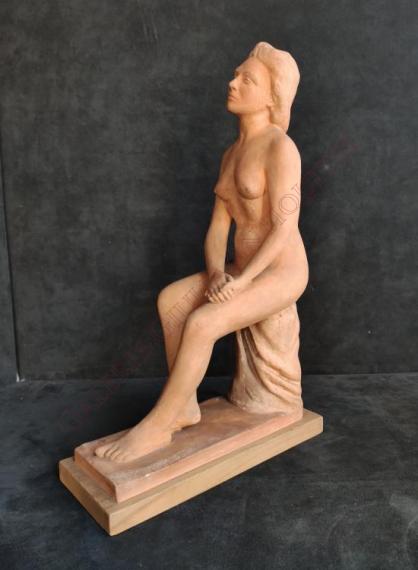Santo Caslini - Terracotta sculpture Naked sitting woman
Submitted by Massimo Sarandrea on the 11th of April 2020
The small terracotta sculpture depicting a young naked woman sitting on a base represents the classic compositional motif, dear to the artist, who had the most studied and reproduced subjects in small nudes, heads and horses, especially in his early years as a master of art ranging from 1935, the year of his diploma, until the first years after the war.
In the composition of this small sculpture one can well understand the influence of his academy teachers at Isia in Monza who were Arturo Martini and Marino Marini and the subsequent knowledge in his Florentine passage with Libero Andreotti, which is clearly evident in the choice both of the compositional material, and of the forms of the sculpture themselves with a severe taste and with a constant reference to a classicism that is calmly opposed to experimental frenzies, often inconsistent.
Santo Caslini was born in Carate Brianza on November 1, 1912. He graduated in 1935 with the diploma of master of art. His first works of sculpture in wood and terracotta date back to this period.
In the second half of the 1930s the artist opened a first studio in Milan with other sculptors and in the same period his first participations in group exhibitions took place in Italy, including the 1936 Venice Biennale - (3rd sculpture prize ) and abroad at the National Museum of France in Paris in 1938. In the middle of the war, despite the call to arms, he continued his activity by presenting his first solo exhibition at the Gianferrari gallery in Milan in 1939 and participating in the first exhibition of Italian artists in arms in Rome in 1942.
Immediately after the war, after transferring the studio to Carate Brianza, he began teaching at the Civic Evening School of the Villa Reale in Monza in the sculpture section, where he will remain in charge for about thirty years.
During the 1950s, he reached full expressive maturity manifested in the construction of the bronze fountain for Piazza Roma in Seregno in 1955, and always in the same location as the "secular Pietà" for the war memorial in the San Carlo district in 1956.
Worthy of note are the panels for the Capitol cinema in Monza named after Queen Teodolinda of 1959. The 1960s saw him intensify his presence at particularly important exhibitions, such as the Milan Art Biennale, the Quadrennial d ' 1965 art of Rome, the 1967 permanent exhibition of Milan.
He died in Carate Brianza on 1st April 1999.


